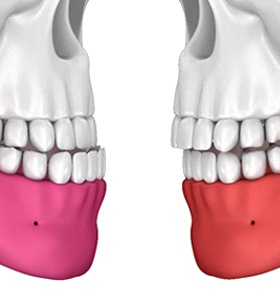
Orthognathic Surgery – Jacksonville, FL
Safe & Effective Corrective Jaw Surgery

Many people believe that orthodontic treatment is all that is necessary to achieve a well-aligned bite. However, the jaw’s alignment also plays a big role in how the mouth looks and functions. When a patient requires jaw straightening or realignment that cannot be effectively accomplished using traditional orthodontic treatment, orthognathic surgery may be necessary. While orthognathic surgery is able to improve the appearance of your jawline and face, it can also increase your jaw function and relieve pain.
WHY CHOOSE ORTEGA ORTHODONTICS FOR ORTHOGNATHIC SURGERY?
- Dual board-certified dentist in orthodontics & prosthodontics
- Only use the latest, state-of-the-art technology
- Patient comfort is priority #1
What Is Orthognathic Surgery and What Are Its Benefits?

“Orthognathic” is a big word, but it simply refers to a special type of oral and maxillofacial surgery that focuses on jaw alignment. It is often planned in conjunction with traditional orthodontic treatment. Some potential benefits of orthognathic surgery include:
- Improved facial aesthetics and higher self-esteem
- Improved ability to chew and swallow
- Reduction of speech problems
- Reduced risk of dental damage due to misaligned teeth
- A correction of the upper airway, resulting in the elimination of obstructive sleep apnea
Is the Surgery Really Necessary?

All surgeries carry a certain amount of risk, which is why Dr. Holland does not recommend orthognathic surgery lightly. Before we plan your procedure, we will carefully evaluate your jaw and the rest of your oral anatomy. After Dr. Holland explores all possible treatment options, including non-surgical possibilities, he will let you know which one he believes is best for your unique situation. Birth defects and facial trauma are two of the most common reasons behind orthognathic surgery.
The Process of Getting Orthognathic Surgery

Most patients wear braces for a year or longer prior to their surgery. Then, the orthognathic treatment process begins with computerized imaging in order to establish and exhibit the benefits that can be achieved through surgical correction. Surgery and treatment will be determined prior to the day of your surgery. Once your jaws are repositioned, very small screws and titanium plates are used to strengthen and stabilize it.
After Orthognathic Surgery

Thanks to the improvements made in the orthognathic field, patients are able to return to their daily activities fairly soon following surgery. You may experience some soreness and swelling after your procedure, but those should dissipate relatively quickly. Because the majority of the surgery is performed inside the mouth, you will likely not have to worry about any obvious scars affecting your facial appearance.
Following your ortho surgery, you’ll be provided with detailed instructions for postoperative care. You may need to stay away from certain foods for a while. You should also avoid smoking and any strenuous physical activity. Your jaw should be completely healed within six weeks to a few months. Then, Dr. Holland may once again place braces on your teeth to finish correcting your dental alignment. Overall, the entire orthodontic and orthognathic process may take a few years. However, the results are well worth the wait!
Would you like to learn more about corrective jaw surgery and how it might benefit you? Request a consultation with Dr. Holland today.
Orthognathic Surgery FAQs

As you can imagine, as soon as our patients hear the word “surgery,” they have a lot of questions. Dr. Holland and our team are always willing to take the time to share any information people need so they can feel comfortable about their care. Below, you’ll find our answers to some of the most popular questions we receive about orthognathic surgery.
Can I just get braces and skip orthognathic surgery?
Orthognathic surgery is typically recommended because a certain correction to the bite can’t be made with traditional orthodontics alone. If a patient chooses to forgo surgery despite Dr. Holland recommending it, he will do his best to mitigate a patient’s alignment problems with braces and other appliances, but he may not be able to fully correct them.
What type of issues call for orthognathic surgery?
While a mild overbite, underbite, or crossbite can be fixed with regular orthodontics, orthognathic surgery is usually suggested for patients who have a pronounced mismatch between the sizes of their upper and lower jaws. This can be due to one jawbone not developing correctly or a congenital deformation. Facial asymmetry, in which the chin does not line up with the middle of the face, is also often a sign of a serious bite problem that may require surgery.
Will I be asleep or awake during the surgery?
Orthognathic surgery is always performed using general anesthesia, so you will basically sleep right through it and wake up without any memory of the treatment happening. The type of general anesthesia used is much lighter compared to the kind utilized for major surgery, so most patients are able to wake up fairly quickly and experience minimal drowsiness.
Will my insurance help me pay for orthognathic surgery?
Orthognathic surgery can often be covered by dental and/or medical insurance depending on the reason for the procedure. However, it can sometimes fall into a gray area between plastic surgery (which is covered) and cosmetic surgery (which is usually not covered). Before your procedure, we can go over your insurance benefits and provide the documentation necessary so you can maximize your coverage.
Will my jaw be wired shut after surgery?
Following orthognathic surgery, the jaw is wired or rubber-banded closed for about 2-3 weeks in order to ensure proper healing, during which a patient will temporarily need to follow a liquid diet. While this certainly does not sound pleasant, most patients describe the experience as being worth it given the lifetime of health and appearance benefits afterward.